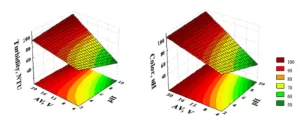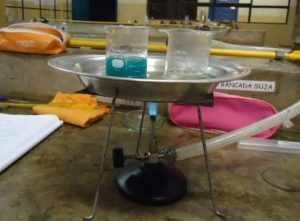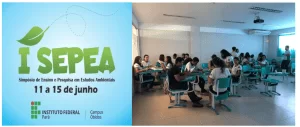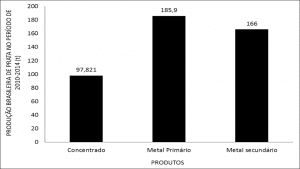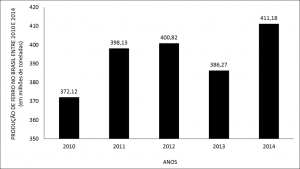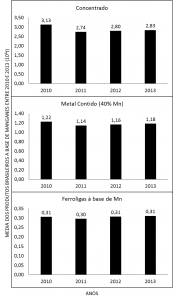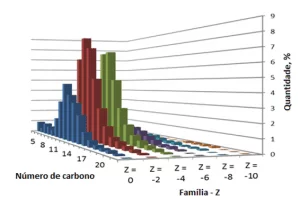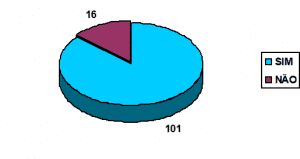BRITTES, Tamires Luara de Oliveira[1], ARAÚJO, Franciolli da Silva Dantas [2], FECURY, Amanda Alves [3] , OLIVEIRA, Euzébio [4], DENDASCK, Carla Viana [5], DIAS, Claudio Alberto Gellis de Mattos [6]
BRITTES, Tamires Luara de Oliveira. Et al. National panorama of niobium between 2010 and 2014. Revista Científica Multidisciplinar Núcleo do Conhecimento. Year 03, Ed. 09, Vol. 08, pp. 29-37 September 2018. ISSN:2448-0959, Access link: https://www.nucleodoconhecimento.com.br/quimica-en/niobium, DOI: 10.32749/nucleodoconhecimento.com.br/quimica-en/niobium
SUMMARY
Mining is the extraction activity of a mineral good from the earth’s crust. Niobium (Nb) is the element of no. 41 in the periodic table of chemical elements, such as transition metal, with its degree of hardness on the mohs scale equal to 6. The main niobium products of industrial interest are currently ferroniobium, niobium pentoxide vacuum alloys and metallic niobium. Brazil is the holder of the largest mineral reserves and leads the market when talking about Niobium, currently its reserves are estimated around 842,460.00 tons with an average content of 0.73% of Nb2O5. With the addition of new policies and contract renewals, Brazil has consolidated its position in the international market, having as main consumers the United States, Japan, Holland, China, Germany, Canada, South Korea, Russia and the United Kingdom. The rise in the price of oil in the period from 2003 to July 2008 made possible new exploration projects and the maintenance of deactivated transmission lines, which required greater production of steel pipes with resistance to heat and low temperatures, which boosted investments in new studies of the use of substances that met the demand , thus growing the internal market of Niobium.
Keywords: Niobium, national market, mining.
INTRODUCTION
The combbio (Cb), better known as niobium (Nb) is one of the chemicals with the lowest concentration on the terrestrial face reaching the proportion of 24 parts per million. It was discovered in the 19th century by the English chemist Charles Hatchett. It is the element of no. 41 in the periodic table of chemical elements, in the category of transition metal, with its degree of hardness on the mohs scale equal to 6, using the comparison measure from 1 to 10, where 1 are the most fragile elements and10 the most resistant (SILVEIRA, 2013).
Niobium is closely linked to tantalum and these are found mainly in the form of cholumbite-tantalite and pyrochlor, niobium is a highly strategic element for Brazil because it holds more than 90% of the world’s washable reserves of ore (SILVEIRA, 2013). The main mineral of Niobium is usually called Tantalita, when the highest content is tantalum and Columbite when niobium content prevails (SILVA et al., 2014).
“In nature there are more than 90 known niobium and tantalum mineral species, of which we can highlight with their respective chemical compositions: columbite-tantalite (Fe, Mn) (Nb, Ta2) O6, with a maximum content of 76% nb2o5; pyrochlor (Na3, Ca)2 (Nb, Ti) (O, F)7, with a maximum content of 71% nb2o5; bariopirochloro (Ba, Sr)2 (Nb, Ti)2 (O, OH)7, with a maximum content of 67% nb2o5; loparite (Ce, Na, Ca)2 (Ti, Nb)2 O6, with a maximum content of 20% nb2o5 and pandaíte (Ba, Sr)2 (Nb, Ti, Ta)2 (O, OH, F)7″ (BRASIL, 2009).
The niobium minerals most found in Brazil and worldwide are Columbite-tantalite and pyrochlor, the first commonly found associated with pegmatites (BRASIL, 2009).
Its potential is closely linked to the use of by-products that give more resistance to alloys that with niobium adhering acquire a much greater oxidation resistance due to its properties highly resistant to corrosion and heat thus transforming them into superalloys, also allowing it to be used in the automotive, space, war, petrochemical, nuclear and several other areas (BRAZIL , 2009)
The most common additions of niobium are in the range of 0.04%, so for each ton of steel 400g niobium are added, in the various superalloys that use this element stand out the INCONEL 718 with a content of 5.3% of Nb, the INCONEL 706 with 3% of Nb and the INCONEL 625 with 3.5% of Niobium, being used mainly for jet and military engines , nuclear and cryogenic industry (BRASIL, 2009)
The main mineral reserves of Niobium are found in Brazil (98.43%), located in the West of the State of Minas Gerais, in the Region of Alto Parnaíba, in the municipalities of Araxá and Tapira, in Goiás in the municipalities of Catalão and Ouvidor, in the Amazon in São Gabriel da Cachoeira and Presidente Figueiredo and in Canada (1.11%) reservations are in Saint Honoré, in the French province of Quebec and Ontario (BRASIL, 2009; SILVEIRA, 2013; BRAZIL, 2015a).
Mining is the activity of extracting a mineral good from the earth’s crust (GANEM et al., 2016). It is one of the main primary sectors in Brazil and worldwide, being the basis for several other areas of human activity, has always been the subject of controversy for having a huge environmental impact, but it is also responsible for the well-being and quality of life of the population in general (FARIAS, 2002). In 2014, the federal revenue obtained from mining reached the value of 40 billion, which represented 5% of the national industrial GDP (BRASIL, 2015b). Mineral is defined as a homogeneous crystalline and inorganic solid with defined physical and chemical composition and formed naturally in the earth’s crust through the various physical-chemical processes that transform it, the vast majority of minerals are in solid state (CURI, 2014; DNPM, 2017).
Mineral deposit is the result of geological processes that have been happening throughout geological time since when the first rocks solidified on the planet. Jazida is a concentration on the earth’s surface or inside it with a certain added value, when it is exploited it is called mine (Curi, 2014). Mineral reserve is a mineral occurrence identified so that it can be explored and has added economic value (CURI, 2014).
In 2010, Brazil accounted for 96% of the world’s supply of Niobium, yielding US$ 1.5 billion to Brazilian industry, almost 90% of the production is destined to those who make use of ferroniobium alloys, with the steel industry being the main consumer. Most of the Brazilian domestic production is destined to the foreign market, only a small part of the production of Minas Gerais, which is the only one that supply the domestic market, allocates a portion of its produced amount to domestic consumption. In 2011 CBMM passed on to national metallurgical companies less than 10% of its total production of standard ferroniobium alloys (SILVEIRA, 2013).
Export consists of the act of temporary or definitive exit of goods or services from a country that can be paid or free of charge (BRASIL, 2015; 2015b). FOB is the U.S. acronym (Free On Board) that indicates that the exporter is responsible for the goods until it is safe on a cargo ship at a port designated by the buyer (IPEA, 2010). Water transport is the main way of selling goods between Brazil and foreign trade (BRASIL, 2012).
Goal
Quantitatively present the world reserve, world production, production, export, import, apparent consumption and average price in Brazil during the years 2010 to 2014.
Method
This research was carried out in the database of DNPM (http://www.dnpm.gov.br/) the National Department of Mineral Production of Brazil. To get the data was left on the entry page of the site and in the collection options clicked on “Publications” after, clicked on the icon of the “Statistical Series and Mineral Economy”, then clicked on the diamond icon to access the options of “Mineral Summary”. Next, the “Brazilian Mineral Summary” was downloaded from 2009 to 2015, thus obtaining the withdrawal of information about “Reserves”, “World Production”, “Production in Brazil”, “Export in Brazil”, “Import in Brazil”, “Apparent Consumption in Brazil” and “Average Price in Brazil” all these data about the mineral Niobium between the years 2010 to 2014. The data was compiled within the Excel application, a component of the Microsoft Corporation Office suite. The bibliographic research was done in mineral summaries made available by DNPM, using for the search computers of the computer laboratory of the Federal Institute of Education, Science and Technology of the state of Amapá, Macapá campus, located on Highway BR 210 KM 3, s/n – Bairro Brasil Novo. ZIP Code: 68.909-398, Macapá, Amapá, Brazil.
Results
Figure 1 shows the average of the niobium world reserve between 2010 and 2014. Brazil had the highest average among other countries followed by Canada.
Figure 1: Average of the world mineral reserve of Niobium.
Figure 2 shows the average world production of Niobium between 2010 and 2014. In the graph it is possible to note that Brazil has a higher average than other countries in niobium production.
Figure 2: Average world production of Niobium.
Figure 3 shows the average niobium production in Brazil between 2010 and 2014. The concentrate is in greater quantity, then the Fe-Nb alloy and Niobium Oxide in a slightly smaller amount than the rest.
Figure 3: Average world niobium production in Brazil.
Figure 4 shows the average export and import of Niobium in Brazil between 2010 and 2014. In this comparative chart it is possible to see that there is more export than niobium import. This is because Brazil holds more than 90% of the reserves of this mineral and therefore meets domestic demand.
Figure 4: Average export and import of Niobium in Brazil.
Figure 5 shows the average of niobium’s apparent consumption in Brazil between 2010 and 2014. The average shows a higher consumption of Fe-Nb Alloy.
Figure 5: Average of apparent niobium intake in Brazil.
Figure 6 shows the average niobium price in Brazil between 2010 and 2014. In the figure it is possible to notice that the highest average is that of Fe-Nb Alloy.
Figure 6: Average niobium price in Brazil.
Discussion
The reserves accounted for and approved by the DNPM totaled 842,460,000 tons with an average content of 0.73% of Nb2O5, these deposits are associated with carbonatitic alkaline complexes. The deposits of Minas and Goiás constitute the carbonatitic alkaline province of Alto Parnaíba that has been forming since the Cretaceous period and are embedded with shales and quartzites covering a circular area of 4.5 km in diameter consisting of metasonate maphrocks, cut by carbonatites and phosphosites. The Niobium in the state of Amazonas was originally formed from the pyrochlorines of the carbonatites formed by the intense rains of the region that served to leach the soil. Probably the formation of niobium reserves in Canada and other countries took place in the same way (BRASIL, 2009).
Brazil is a leader in the world production of Niobium. This can be explained by the fact that Brazil holds more than 90% of the world’s niobium reserves, which maintains the exclusivism that our country holds from the mineral (SILVEIRA, 2013).
The production of Fe-Nb concentrate and alloy is probably higher because of the United States, one of the largest consumers of The Brazilian Niobium, the concentrate and the Fe-Nb niobium alloy is widely used by Americans in the defense, aerospace and energy industries, which explains the large amount of Niobium imported by that country (SILVEIRA, 2013).
The massive export and almost non-existent import can be explained by the mineral concentration of Niobium in the world, with Brazil in the lead with more than 90% of the world’s reserves, which makes it unnecessary to import this substance, because the domestic market supplyits demand (SILVEIRA, 2013).
The high demand of Fe-Nb alloy probably occurs because the steel industry is one of the main consumers of ore and it mainly uses Fe-Nb alloys because of its greater resistance to abrasion and heat, being used mainly in microalloyed steels which provides a better performance in its physical-chemical properties leaving it highly resistant, which would not happen if it was replaced by Vanadium or Titanium (BRAZIL , 2009).
The average price of Niobium in Brazil has probably increased over the years due to the growing interest of the United States and several other countries in the use of these Niobium byproducts. With the growing demand for Fe-Nb alloy Brazil saw the need to make new investments and renew contracts, all this contributed to the appreciation of the prices of this metal. This is probably also the case with the growing perception of niobium advantages over other competing metals and ultimately pressing prices (SILVEIRA, 2013).
CONCLUSION
The Niobium is taking more and more space in international trade, currently, the world industries are increasingly dependent on this metal and the various technologies also, considered a rare mineral, large holder of most of the mineral reserves of this metal, brings numerous economic advantages to Brazil. It is speculated that the policies taken by the Brazilian government regarding international competitiveness are still ineffective, although recent policies and contract renewals have given stability to the Brazilian niobium market. The average prices of the Fe-Nb league fell significantly after the 2008 economic crisis, reflecting in 2010 prices. It is estimated that the Niobium market will stabilize and continue growing, the ore, a target of greed in many countries was also found by the mining company Niocop, located in Elk Creek in the United States and the plans were to start mining activity in 2016, although it has reserves measured in 81.2 million and this will soon make it the fourth largest niobium producer in the world Brazil will always maintain the leadership due to its favorable geographical position.
REFERENCES
BRASIL. Sumário Mineral – Nióbio. Brasília: Departamento Nacional de Produção Mineral DNPM 2009.
______. Panorama da Navegação Marítima e de Apoio: Superintendência de Navegação Marítima e de Apoio: 39 p. 2012.
______. Informações e Análises da Economia Mineral Brasileira Brasilia: Instituto Brasileiro de Mineração IBRAM, 2015. 25p.
______. Sumário Mineral – Nióbio. Brasília: Departamento Nacional de Produção Mineral DNPM 2015a.
______. Exportação. 2015b. Disponível em: < http://idg.receita.fazenda.gov.br/orientacao/aduaneira/importacao-e-exportacao/despacho-aduaneiro-de-exportacao. >. Acesso em: 13 de novembro, 2017.
CURI, A. Minas a céu aberto: Planejamento de lavra. São Paulo: Oficina de Textos, 2014. 232p. Disponível em: < http://www.dnpm-pe.gov.br/Geologia/Mineracao.php >.
DNPM. Mineral. 2017. Disponível em: < http://www.dnpm-pe.gov.br/Detalhes/Mineral.htm >. Acesso em: 14 de novembro, 2017.
FARIAS, C. E. G. Mineração e meio ambiente no Brasil: CGEE: 40 p. 2002.
GANEM, R. S.; FILHO, A. F. F.; GANEM, R. S. I. Impactos Socioambientais de Mineração: Estudo de Caso em Pedreira. IV Congresso Baiano de Engenharia Sanitária e Ambiental. Cruz das Almas BA 2016.
IPEA. O que é? FOB. 2010. Disponível em: < http://desafios.ipea.gov.br/index.php?option=com_content&view=article&id=2115:catid=28&Itemid=23 >. Acesso em: 07 de novembro de 2017.
SILVA, J. P. P.; MEIRA, L. D. A. S.; SILVA, R. P. Caracterização Mineralógica em Minério de Tântalo e Nióbio de Porto Grande-AP. HOLOS, v. 3, p. 378-385, 2014.
SILVEIRA, J. W. Competição no Mercado Internacional de Nióbio: Um Estudo Econométrico. 2013. 76 p. (Dissertação). Instituto de Economia, Universidade Federal do Rio de Janeiro, Rio de Janeiro RJ.
[1] High school student. Technical Course in Mining. Federal Institute of Basic, Technical and Technological Education of Amapá (IFAP).
[2] Materials Technologist. Master in Materials Science and Engineering. Researcher Professor, Federal Institute of Basic, Technical and Technological Education of Amapá (IFAP)
[3]
Biomedical. PhD in Tropical Diseases. Researcher Professor, Federal University of Amapá (UNIFAP). Biologist. Doctor of Tropical Diseases. Researcher Professor at the Federal University of Pará (UFPA).
[4] Biologist. Doctor of Tropical Diseases. Researcher Professor at the Federal University of Pará (UFPA).
[5] Theologian. PhD in Clinical Psychoanalysis. Researcher at the Center for Research and Advanced Studies, São Paulo, SP.
[6] Biologist. PhD in Theory and Behavior Research. Researcher Professor, Federal Institute of Basic, Technical and Technological Education of Amapá (IFAP)







